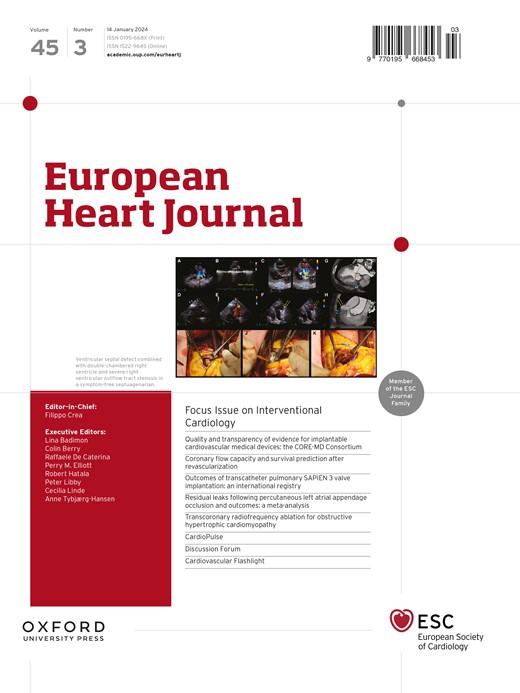Pre-treatment lysis time of plasma-derived fibrin clots and bleeding in patients on oral anticoagulants for atrial fibrillation in the ARISTOTLE trial
IF 37.6
1区 医学
Q1 CARDIAC & CARDIOVASCULAR SYSTEMS
引用次数: 0
Abstract
Background and Aims Oral anticoagulation reduces stroke risk in patients with atrial fibrillation (AF) but increases bleeding. Longer fibrin clot lysis time has been shown to predict adverse cardiovascular outcomes in acute coronary syndromes. This study explored relationships between fibrin clot lysis time at randomization and clinical outcomes in patients with AF enrolled in the Apixaban for Reduction in Stroke and Other Thromboembolic Events in AF (ARISTOTLE) trial. Methods Plasma samples were obtained from anticoagulation-naïve participants, before initiation of study medication (n = 1841). Fibrin clot turbidimetry was performed, and lysis time determined. Associations between lysis time and characteristics, biomarkers, and on-treatment bleeding and cardiovascular events were assessed by lysis time quartile (Q1-4, shortest to longest). Results A shorter lysis time was associated with being older, male, permanent AF, lower body mass index, estimated glomerular filtration rate and C-reactive protein, and higher N-terminal pro-B-type natriuretic peptide. Major and clinically relevant non-major bleeding was significantly more frequent in lysis time Q1 vs. Q4 [6.3%/yr vs. 2.1%/yr; HR, 2.99 (95% CI, 1.75–5.12); P = .001], including after multifactorial adjustment [HR, 2.61 (1.45–4.69); P = .016]. Those in Q2 and Q3 had intermediate bleeding risk vs. Q4 [HR, 2.21 (1.27–3.87); 2.08 (1.18–3.66) respectively], suggesting a graduated effect. Treatment allocation to apixaban vs. warfarin did not affect the relationship between lysis time and bleeding (interaction-P = .80). There was no significant association between lysis time and a composite of cardiovascular death, stroke, systemic embolism or myocardial infarction. Conclusions Shorter pre-treatment fibrin clot lysis time independently predicted higher bleeding risk in patients receiving oral anticoagulation for AF.亚里士多德试验中口服抗凝剂治疗房颤患者血浆源性纤维蛋白凝块和出血的治疗前溶解时间
背景和目的口服抗凝可降低心房颤动(AF)患者的卒中风险,但会增加出血。较长的纤维蛋白凝块溶解时间已被证明可预测急性冠状动脉综合征的不良心血管结局。本研究探讨了随机分配时纤维蛋白凝块溶解时间与参加阿哌沙班减少房颤卒中和其他血栓栓塞事件(亚里士多德)试验的房颤患者临床结果之间的关系。方法在研究用药开始前,从anticoagulation-naïve参与者获得血浆样本(n = 1841)。纤维蛋白凝块浊度法测定,并测定裂解时间。通过溶解时间四分位数(Q1-4,从最短到最长)评估溶解时间与特征、生物标志物、治疗中出血和心血管事件之间的关系。结果较短的溶解时间与年龄、男性、永久性房颤、较低的体重指数、肾小球滤过率和c反应蛋白的估计以及较高的n端前b型利钠肽有关。主要出血和临床相关的非主要出血在溶解时间Q1比Q4明显更频繁[6.3%/年比2.1%/年;Hr, 2.99 (95% ci, 1.75-5.12);P = .001],包括多因素调整后[HR, 2.61 (1.45-4.69);P = 0.016]。Q2和Q3组的出血风险中等,Q4组的风险比为2.21 (1.27-3.87);2.08(分别为1.18-3.66),表明存在递进效应。阿哌沙班和华法林的治疗分配不影响溶解时间和出血之间的关系(相互作用p = 0.80)。溶解时间与心血管死亡、中风、全身性栓塞或心肌梗死之间没有显著关联。结论治疗前纤维蛋白凝块溶解时间较短独立预测口服抗凝治疗房颤患者出血风险较高。
本文章由计算机程序翻译,如有差异,请以英文原文为准。
求助全文
约1分钟内获得全文
求助全文
来源期刊

European Heart Journal
医学-心血管系统
CiteScore
39.30
自引率
6.90%
发文量
3942
审稿时长
1 months
期刊介绍:
The European Heart Journal is a renowned international journal that focuses on cardiovascular medicine. It is published weekly and is the official journal of the European Society of Cardiology. This peer-reviewed journal is committed to publishing high-quality clinical and scientific material pertaining to all aspects of cardiovascular medicine. It covers a diverse range of topics including research findings, technical evaluations, and reviews. Moreover, the journal serves as a platform for the exchange of information and discussions on various aspects of cardiovascular medicine, including educational matters.
In addition to original papers on cardiovascular medicine and surgery, the European Heart Journal also presents reviews, clinical perspectives, ESC Guidelines, and editorial articles that highlight recent advancements in cardiology. Additionally, the journal actively encourages readers to share their thoughts and opinions through correspondence.
 求助内容:
求助内容: 应助结果提醒方式:
应助结果提醒方式:


